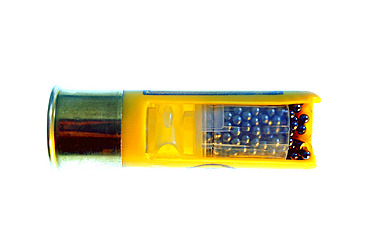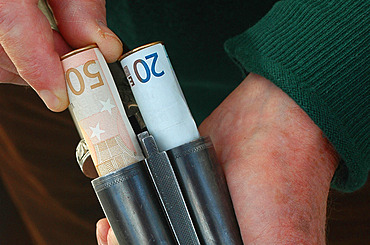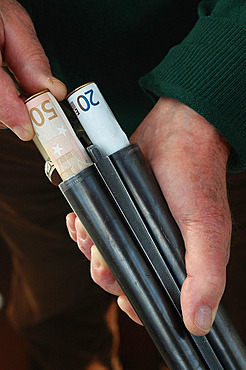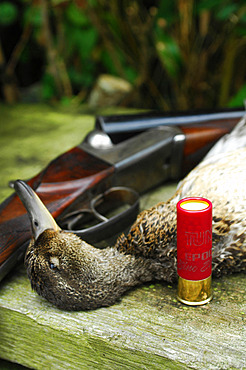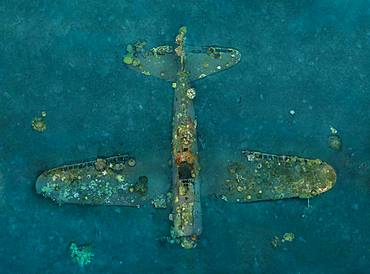Recent searches
Loading...
860-290375 - France. Hunting. The European commission has adopted in january 2021 a ban on using lead 100m around any wetland in Europe. So far in France, the ban is only 30m. In the future, the lead will be totally banned as 6000 tons of lead is put into nature by hunters every year. There is already new anmunitions with zinc, steel, tungsten and bismuth.
860-290377 - France. Hunting. The European commission has adopted in january 2021 a ban on using lead 100m around any wetland in Europe. So far in France, the ban is only 30m. In the future, the lead will be totally banned as 6000 tons of lead is put into nature by hunters every year causing death of thousands of birds (here a mallard) eating lead balls.
860-290374 - France. Hunting. Lead balls. The European commission has adopted in january 2021 a ban on using lead 100m around any wetland in Europe. So far in France, the ban is only 30m. In the future, the lead will be totally banned as 6000 tons of lead is put into nature by hunters every year. There is already new anmunitions with zinc, steel, tungsten and bismuth.
860-290371 - France. Hunting. The European commission has adopted in january 2021 a ban on using lead 100m around any wetland in Europe. In the future, the lead will be totally banned as 6000 tons of lead is put into nature by hunters every year. There is already new anmunitions with zinc, steel, tungsten and bismuth but much more expansive than lead.
860-290370 - France. Hunting. The European commission has adopted in january 2021 a ban on using lead 100m around any wetland in Europe. So far in France, the ban is only 30m if using new anmunitions with zinc, steel, tungsten and bismuth. Here a teal and a new anmunition with tin.
860-290376 - France. Hunting. The European commission has adopted in january 2021 a ban on using lead 100m around any wetland in Europe. So far in France, the ban is only 30m. In the future, the lead will be totally banned as 6000 tons of lead is put into nature by hunters every year causing death of thousands of birds (here a mallard) eating lead balls.
860-290373 - France. Hunting. The European commission has adopted in january 2021 a ban on using lead 100m around any wetland in Europe. So far in France, the ban is only 30m. In the future, the lead will be totally banned as 6000 tons of lead is put into nature by hunters every year. There is already new anmunitions with zinc, steel, tungsten and bismuth.
860-290372 - France. Hunting. The European commission has adopted in january 2021 a ban on using lead 100m around any wetland in Europe. In the future, the lead will be totally banned as 6000 tons of lead is put into nature by hunters every year. There is already new anmunitions with zinc, steel, tungsten and bismuth but much more expansive than lead.
860-290368 - France. Hunting. The European commission has adopted in january 2021 a ban on using lead 100m around any wetland in Europe. So far in France, the ban is only 30m. In the future, the lead will be totally banned as 6000 tons of lead is put into nature by hunters every year. There is already new anmunitions with zinc, steel, tungsten and bismuth.
860-290369 - France. Hunting. The European commission has adopted in january 2021 a ban on using lead 100m around any wetland in Europe. So far in France, the ban is only 30m if using new anmunitions with zinc, steel, tungsten and bismuth. Here a teal and a new anmunition with tin.
860-287442 - Tara Pacific expedition - november 2017 Kimbe Bay, papua New Guinea, Zero wreck: Coral growth on this wreck is from a period of 74 years ! D: 15 m The ZERO, is a Japanese WW2 fighter plane wreck. This Zero wreck was discovered in January 2000 by local William Nuli while he was freediving for sea cucumbers. He asked the Walindi Plantation Resort dive team if they might know what it was, and when they investigated they uncovered the intact wreck of a Zero fighter, resting on a sedimented bottom in 15 m depth. This World War II Japanese fighter is almost completely intact. The plane is believed to have been ditched, the pilot is believed to have survived, but was never found on the island. He never returned home. Maybe he disappeared in the jungle? On 26th December 1943, during the battle of Cape Gloucester, the Japanese pilot made an emergency landing, ditching his Mitsubishi A6M Zero plane into the sea approximately 100m off West New Britain Province. The plane was piloted by PO1 Tomiharu Honda of the 204st K?k?tai. His fate is unknown but it is believed the he made a controlled water landing after running out of fuel and survived. Although he failed to return to his unit, the plane was found with the throttle and trim controls both set for landing and the canopy was open. There are no visible bullet holes or other shrapnel damage and the plane is still virtually intact after over 70 years underwater. It is a A6M2 Model 21 Zero, made famous for its use in Kamikaze attacks by the Japanese Imperial Navy. The wreck has the Manufacture Number 8224 and was built by Nakajima in late August 1942.
860-287440 - Tara Pacific expedition - november 2017 Zero wreck, vertical view Orthomosaic from 3D photogrammetry (13500 x 10000 px). D: 15 m Kimbe Bay, papua New Guinea, Coral growth on this wreck is from a period of 74 years ! The ZERO, is a Japanese WW2 fighter plane wreck. This Zero wreck was discovered in January 2000 by local William Nuli while he was freediving for sea cucumbers. He asked the Walindi Plantation Resort dive team if they might know what it was, and when they investigated they uncovered the intact wreck of a Zero fighter, resting on a sedimented bottom in 15 m depth. This World War II Japanese fighter is almost completely intact. The plane is believed to have been ditched, the pilot is believed to have survived, but was never found on the island. He never returned home. Maybe he disappeared in the jungle? On 26th December 1943, during the battle of Cape Gloucester, the Japanese pilot made an emergency landing, ditching his Mitsubishi A6M Zero plane into the sea approximately 100m off West New Britain Province. The plane was piloted by PO1 Tomiharu Honda of the 204st K?k?tai. His fate is unknown but it is believed the he made a controlled water landing after running out of fuel and survived. Although he failed to return to his unit, the plane was found with the throttle and trim controls both set for landing and the canopy was open. There are no visible bullet holes or other shrapnel damage and the plane is still virtually intact after over 70 years underwater. It is a A6M2 Model 21 Zero, made famous for its use in Kamikaze attacks by the Japanese Imperial Navy. The wreck has the Manufacture Number 8224 and was built by Nakajima in late August 1942.
1167-1129 - Medal ceremony Men's 100m on big screen, Olympic flame, crowds, Olympic Stadium, London 2012, Olympic Games, London, England, United Kingdom, Europe
1161-7105 - Chateau de Trois Tours and Bordelais vineyards in the Bordeaux wine region of France
857-58685 - Photographs from 100m high Wind Turbines in Germany.
857-58684 - Photographs from 100m high Wind Turbines in Germany.
857-58694 - Photographs from 100m high Wind Turbines in Germany.
857-58686 - Photographs from 100m high Wind Turbines in Germany.
857-58698 - Photographs from 100m high Wind Turbines in Germany.
857-58683 - Photographs from 100m high Wind Turbines in Germany.
857-58682 - Photographs from 100m high Wind Turbines in Germany.
857-58687 - Photographs from 100m high Wind Turbines in Germany.
857-58680 - Photographs from 100m high Wind Turbines in Germany.
857-58695 - Photographs from 100m high Wind Turbines in Germany.
734-234 - The start line of the 100m inside The Olympic Stadium, London, England, United Kingdom, Europe
770-1157 - Fjadrargljufur Canyon, 100m deep and 2 km long, carved out of palagonite and lava layers by glacial river two million years ago, near Kirkjubaejarklaustur, South Iceland, Iceland, Polar Regions
29-1886 - Interior of the Gruta do Janelao, a limestone cave passage 100m high, lit through roof window, at Peruacu in Minas Gerais state, Brazil, South America
You reached the end of search results
